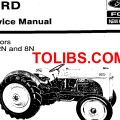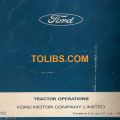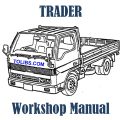1983-2009 Ford Truck Spare Parts Catalog and Accessories
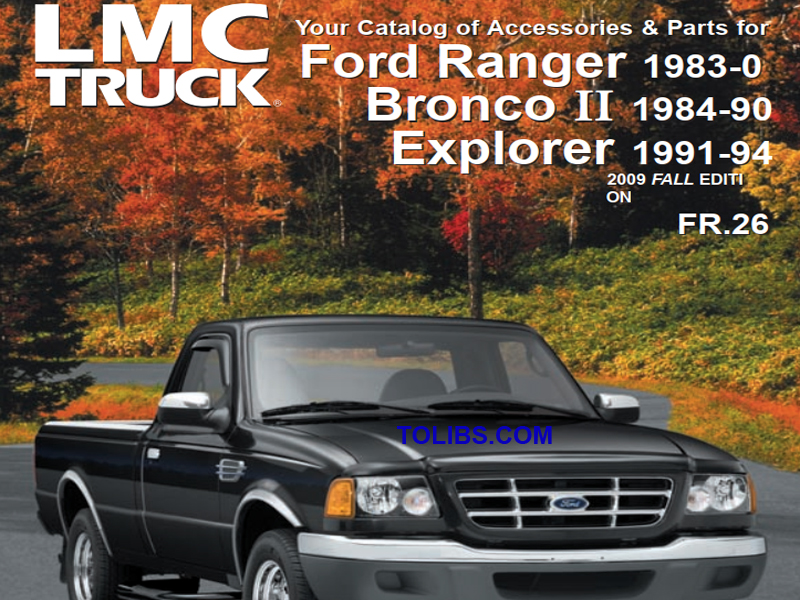
Your Catalog of Accessories & Parts for
- Ford Ranger 1983-0
- Ford Bronco II 1984-90
- Ford Explorer 1991-94
Ford Ranger hiSTORY Key information:
- 1983: Introduced in March 1982 as a 1983 model, built at the Louisville, Ky. plant. The Ranger was a scaled down F-Series. Double wall construction hood, doors, roof, box side and tailgate made the Ranger as sturdy as its big brother. Available as a 4x2 and 4x4, it came with three variations of 4 cylinder engines and one V6. From its introduction the Ranger was America's best selling compact truck for 8 of the next 10 years.
- 1984: Ranger styling was left alone. Trimwise the XLS and XLT models were offered. The Ranger S model was the stripped down "value" model.
- 1985: 232,771 Rangers were sold in 1985. A 2.3L 143 cid EFI Turbo Diesel 4 cylinder was offered. Styling remained unchanged.
- 1986: The new Super Cab was an immediate success. With 17 inches of additional room behind the front seat, the Ranger now had the same configuration as the F-Series.
- 1987: The High Rider 4x4 model was offered. It included a bed-mounted light bar, front Bush Bar, and improved handling. New styled white painted wheels were optional. All radios had an electronic display and included a clock. ABS rear brakes were standard on all models.
- 1988: America's best selling compact truck set a sales record of 367,212 trucks sold. The GT Package now joined the Custom, XLT and STX options. Both ground effects front spoiler and rocker panel skirting with sportier suspension made the GT package unique. 1988 was the last year of a carbureted engine, the 2.0L 122 cid, in a Ranger.
- 1989: A new front restyle made the Ranger style match the F-Series. Aerodynamically Flush Halogen headlights, wraparound turn signals, wraparound front bumper, all new hood and cowl and reshaped front fenders completed the update. The first Ford engine not to have a distributor was the 2.3L 140 cid EFI. It came with two spark plugs per cylinder and was the standard engine in the Ranger. All Ranger engines now came with EFI, electronically controlled fuel injection.
- 1990: A 4.0L 242 cid EFI V6 engine was offered and only available with the automatic overdrive transmission. The DANA 35 replaced the DANA 28 front axle.
- 1991: A sport model was added to the Ranger lineup with special paint, tape stripe package and special aluminum wheels. The 3.0L 183 cid EFI V6 was introduced.
- 1992: The big 4.0L 242 cid EFI now came with a 5-speed overdrive manual transmission. As the best-selling compact truck in America, Ford made few changes for 1992.
- 1993: The Ranger was completely restyled for 1993. The boxy look was dropped for a new streamlined appearance. The front end became more rounded and the front bumper wrapped around the fenders. Wheel wells became more pronounced with a wider flare. The new Flareside Splash model was introduced. Access to the cab was made easier with wider front doors. The 2.9L V6 engine was replaced with a 3.0L 182 cid.
- 1994: The Splash was now available as a Super Cab. For improved side impact safety, side door guard beams were added to all models.
- 1995: A driver's side airbag was added. All wheel ABS became standard for all four-wheel drive models and models with the 4.0L engine. A new electronic 4 speed automatic transmission was now available. The instrument panel received a facelift as well as the front grille.
- 1996: The Flareside bed was no longer exclusively available as a Splash model. Passenger side air bags were added as an option.
- 1997: A new five speed automatic transmission was offered as an option. A stereo with a single disc player was added as well as an extra power point for accessories.
- 1998: The Ranger increased its standard cab depth by three inches adding more legroom. The front of the truck received a new look with a new bumper, valance, grille, front lights and a steel or aluminum hood. A 2.5L 153 cid engine replaced the 2.3L engine. A wishbone type coil spring or torsion bar front suspension replaced the old coil spring Twin I-Beam. An all-electric Ranger EV was introduced for fleet sales only. The four-wheel drive could now be engaged on-the-fly with a dash switch.
- 1999: The Super Cab now came with four doors. The Splash model was dropped leaving available trim levels as the XL and XLT with optional sport appearance packages. A fully boxed frame now made the Ranger a tougher truck all around.
- 2000: Minor trim level changes were made for the Ranger in 2000. The XL received a new Trailhead package and the XLT received a new 4x4 Off-Road Group package.
- 2001: A new grille, front bumper, valance and crystal clear headlights gave the Ranger a custom appearance for 2001. The Ranger added a new trim level called the Edge. The Edge came standard with aluminum rims and color coordinated bumper, valance and wheel arch moldings. Both the 2WD and 4WD Edge models had the same ride height and came standard with a black vinyl floor. XLT Super Cabs now offered a premium off road package. The 4.0L OHV was replaced with a 4.0L 242 cid SOHC. Four wheel ABS became standard on all models.
- 2002: A fuel-efficient 2.3L 143cid DOHC engine was added and the 2.5L was dropped. A new FX4 off-road model was introduced with forged aluminum wheels, heavyduty suspension and added skid plates. The FX4 came standard with the 4.0L engine. Standard trim levels remained the XL and XLT.
- 2003: A FX4 level II was introduced with a manual transfer case, a torsen® limited slip axle, heavy-duty shocks, forged aluminum wheels and stainless steel tow hooks. The Tremor trim level was added to the FX4 lineup with a 485-watt sound system.
- 2004: New front valances and grille designs were added to give the Ranger a rugged new look much like the F150. Interior changes were minimal. The Tremor was given a new 510-watt sound system, sporty interior design and custom cast aluminum wheels.
- 2005: Interior changes were minimal. Trim levels offered were the XL, XLT, Edge, FX4 Off-Road, FX4 Level II. The Tremor trim level was dropped. A stylish STX trim level was added that had a custom grille, valance, aluminum wheels, running boards, tail lights and fog lights. Ford Ranger has been distinguished as the best selling compact truck for 17 years straight.
- 2006: A new grille with horizontal bars, squared off mirrors and boxed in emblems now gave the Ranger the look of a small F150. Park lights and taillights were changed as well. Minor changes were made to the front bumper and fenders. The Edge was replaced by the Sport, which came in 2WD and 4WD.
- 2007: Minor interior changes were made. The crash safety service was upgraded. A tire pressure monitoring system and a passive anti-theft system were also added as an option. SIRIUS satellite radio and an auxiliary MP3 input jack were added to the premium sound system.
- 2008: A new front bumper with better aerodynamics was added to improve fuel economy. With the new front bumper, fog lights were also redesigned. The FX4 Off-Road Ranger received some performance upgrades and the FX4 LEVEL II and STX trim levels were dropped.
- 2009: Minor interior changes were made. Trim levels offered were the XL, XLT, Sport and FX4 Off-Road. A trailer hitch receiver became standard on all models. The 3.0L engine was dropped leaving the 2.3L and 4.0L as the two engine choices.
Ford Bronco II Key information:
- 1984: The Bronco II was the 4x4 midsize equivalent of the full size Bronco. The same double wall construction hood, doors, roof, box sides and tailgate as the full size Ford. The Twin Traction Beam front axle, 4-speed manual transmission, and 2.8L 170 cid V6 were standard.
- 1985: Styling was carried over, now standard full instrumentation, transfer case skid plates and a 5-speed transmission. Optional was the 2.3L 143 cid EFI 4 cylinder Diesel engine.
- 1986: The 2.9L 179 cid EFI V6 replaced the original 2.8L 170 cid engine. A multiple of exterior colors and two-tone paint scheme were optional.
- 1987: ABS rear wheel braking is now standard on all models. 4x2 two-wheel drive was now available. Optional electric transfer case shifting and Touch Drive were now available.
- 1988: The XL Sports model was now available. White-lettered tires, deepdished cast aluminum wheels, tachometer, brush/grille guard, fog lights, black front bumper and black tubular rear bumper combined to make the XL a cool off-the-road truck.
- 1989: A completely restyled front end was similar to the F-Series design. Automatic transmission shift linkage moved to the steering column. A floor-mounted, rear seat heater was only available on the Bronco II. 1990: No major changes, for this was a short production year, ending in February 1990. This made way for the longer and wider 1991 Explorer to be introduced.
Ford Explorer Key information
- 1991: The 1991 Explorer replaced the Bronco II as the Ford midsized SUV. The front end was similar to the Ranger STX. The vehicle came in two or four doors and was larger than the Bronco II. Trim lines included the XL, XLT and the Eddie Bauer Edition. The only engine available was the 4.0 Liter V6. The Explorer offered optional 4WD or automatic overdrive transmission. A Twin I-Beam front suspension was standard on 2WD models and the Twin Traction front axle came with 4WD models.
- 1992: The Explorer had proven to become the best selling SUV in the U.S. giving Ford no reason to make any changes this year.
- 1993: In 1993 a fully loaded Limited Edition was offered along with the original XL, XLT and Eddie Bauer trim levels. Four wheel ABS became standard on all Explorers.
- 1994: With the continued success as being the most popular SUV in the U.S. there were no reasons to make any significant changes this year.
Chrome Rear Step Bumpers Style and Utility All in One
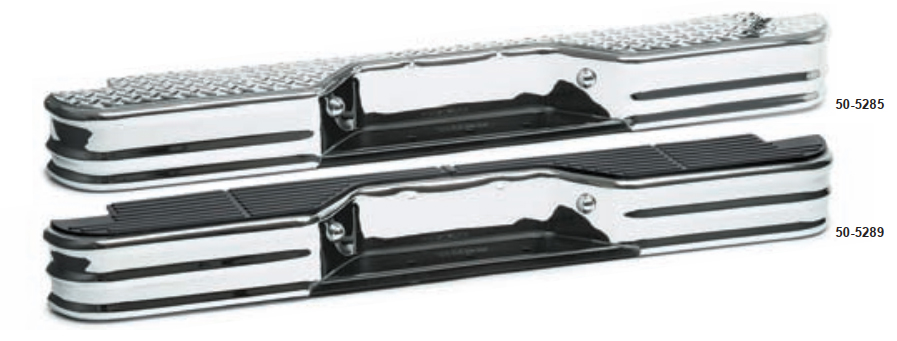
Ford Ranger 1983-09
Chrome Rear Step Bumpers give your truck the ability to tow up to 300 pounds tongue weight and 3,500 pounds trailer weight. These bumpers offer the ease of bolt-on installation, the convenience of a step and come complete with rear license plate lamps. Do not exceed truck manufacturer's recommended towing capacity. A Bumper Mounting Kit #50-0050 is required when installing these rear bumpers.
Chrome Rear Step Bumper - Diamond Tread
This traditional utility bumper features a classic embossed steel top plate on a stylish and reliable step bumper.
Chrome Rear Step Bumper - Polymer Pad
This classic style rear step bumper features a step pad to give your truck that finishing touch. Made from molded polymer, the step pad protects your truck from scratches while the grid pattern adds an excellent anti-skid surface for sure footing while loading and unloading.
After the sell price means Oversize Part Charge. Your order will incur a charge of $20.00. When ordering multiple oversized parts only one Oversize Part Charge of $20.00 will be applied to your order.
Black Rubber Floor Mat
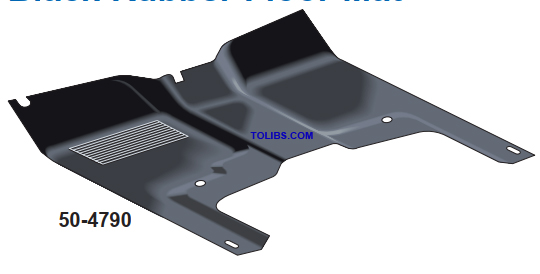
This all black rubber floor mat is molded and ready to go. It is a full replacement mat and is one piece for easy installation. Call or go online and order yours today. This 1/4" thick synthetic Insulation Material is similar to the insulation used in today's trucks. It also makes a great sound deadening material when used underneath rubber floor mats or wherever your truck needs extra insulation.
Reproduction Stainless Steel Door Mirror
- Ranger 1983-92
- Bronco II 1984-90
- Explorer 1991-94
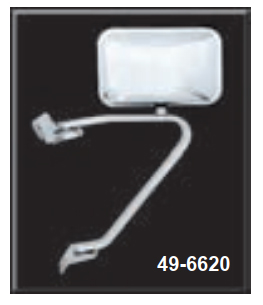
Can be used to replace original style mirror on models equipped with factory internal door mirror brace.
Your Truck Could Be Shown inside this Catalog
You worked hard restoring your truck and now you want others to see it. Send in a glossy (color or black and white) photo of your truck to the address at the bottom of the page - Attn: Graphics Dept. Include your name, address, phone number and a note about what you've done to it. Please add any interesting stories you may have about it. Someday you might see your truck inside this catalog or on our website. Then you can show it off to family, friends and other truck owners.
Why You Should Buy from LMC TRUCK
Dear Ford Ranger Owners:
As your eyes travel this catalog, you'll benefit from: What you need to know about taking care of your truck … how to keep your truck looking good on the inside and out … how to improve performance … how to keep the body of your truck in trim shape, how to make your engine sound great. But that's not all. Here are ten more reasons you should do business with LMC TRUCK based on the satisfied experiences of thousands of customers across the country and abroad.
Window Installation Tips:
- Fit your new window rubber to your cab first, then install the window glass.
- Use a rubber friendly lubricant such as WD40 and the Windshield Stick (#42-0860) to ease installation and avoid damaging your window rubber.
- Window rubber shrinks your new window rubber may appear slightly larger than the original prior to installation.
Windshield and Glass Sealant is silicone and seals windshields, windows, sunroofs and more. Flows into leaks like water but dries to form a flexible, tough, clear seal resistant to extreme temperatures, vibration, shock and most chemicals.
Windshield Stick A glass installer's most useful tool! Can be used to install or remove windows or window rubber. This plastic tool measures 8" in length for an easy grip.
Windshield and Molding
- Ford Ranger 1983-09
- Ford Bronco II 1984-90
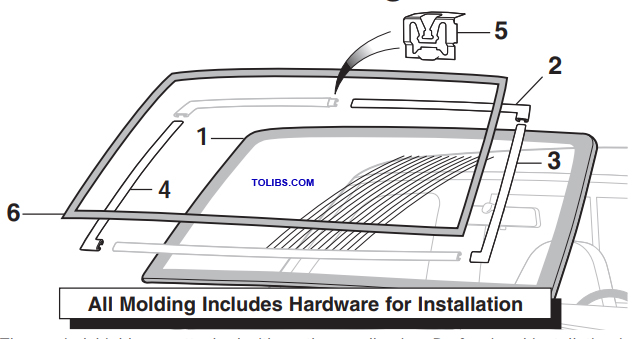
These windshields are attached with urethane adhesive. Professional installation is required. Contact your local glass installer for installation.
Front Steel Body Parts for Ranger 1983-88
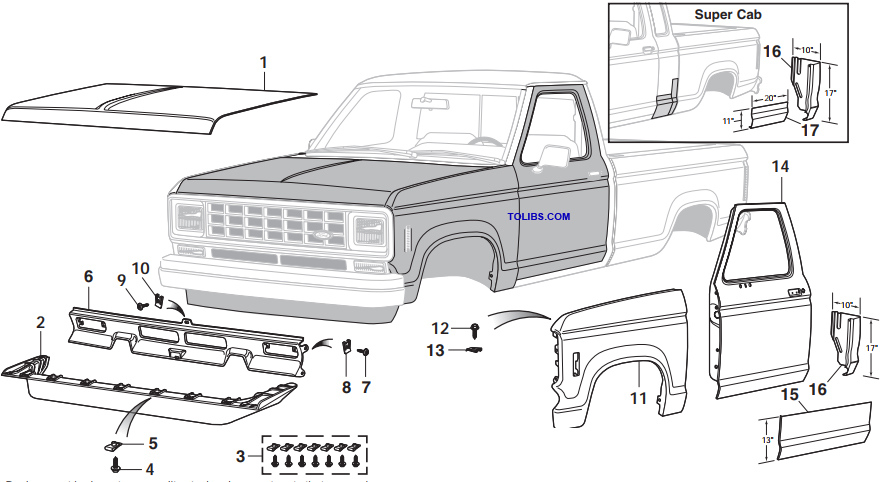
To ensure proper fit of repair panels, do not begin cutting the existing sheet metal until you have received and checked the fit of the new panel. Due to variations between manufacturers, dimensions may vary slightly.
Replacement body parts are quality steel replacement parts that are made overseas. Having been shipped half way around the world by ship and then by truck, there will most likely be a few scratches or small dents; this cannot be helped and should be expected. A small amount of repair may be required. All body parts are packaged and handled with great care.

